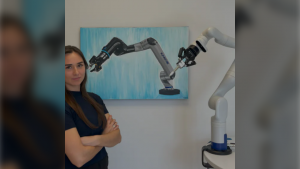Automated robotic technology is about to revolutionize the multi-billion-dollar global art market, if some Canadian engineering students, small business entrepreneurs and art consultants have their way.
They’ve merged art and technology in a computer-controlled device that shows an uncanny ability to create remarkable reproductions of gallery-quality paintings.

A video still shows a robot arm applying paint to a mounted canvas. (Acrylic Robotics)
The AI-powered art robot from tech start-up Acrylic Robotics in Montreal makes use of artificial neural networks and machine learning models to steer a hyper-precise and fast-moving robotic arm with a paint brush attached.
It creates acrylic paintings on canvas, digitally tracking every mechanical stroke it makes as it reproduces an already-existing image stored as a data file. The copy is very precise, almost exact, but with subtle and minor variations based on pigments and paints used, type of brush attached, force of stroke applied and so on.
It’s partly a copy, partly a new work, created by machines that can identify patterns, learn from their previous work, and take in artistic directions or instruction.
Along with the ability to reproduce a single specific artwork by automated robot comes the much larger potential of reproducing artists’ paintings at scale. Much like an author has a book reproduced on a printing press, much like a musician releases a new mass-produced CD, painters may soon see their work much more widely accessed, enjoyed and purchased after being reproduced by robots. Acrylic Robotics provides a range of complementary services and supports for artists it works with, including sales management, manufacturing, distribution and fulfillment solutions.

“Self-portrait,” designed by Chloe Ryan, painted by Acrylic Robots. (Acrylic Robotics)
Acrylic Robotics was co-founded by McGill mechanical engineering student (and fine artist herself) Chloë Ryan, collaborating with a team of mechanical engineering, robotics, software & design students from McGill, McMaster, Waterloo and other universities and tech institutions across Canada.
Following more than three years of iteration and development, the Montreal-based start-up announced the Acrylic Aurograph, and recent live and on-air demonstrations have shown the mechanical artmaker can make near identical copies of original paintings very quickly.
Ryan demonstrated her robotic technology at the Hardware Tech and Founders Showcase in Toronto last fall (held at the tech business development centre OneEleven and hosted by start-up support organization Journey, the hardware exhibit featured several new tech companies, including Acrylic and AAVAA, which is developing ways to turn facial and eye movements into signals that control digital gadgets and devices) .

Matt Chessco’s Lion was created through collaboration between artist and robot. (Matt Chessco)
Acrylic’s AI-powered robot and digital brushstroke tracking and emulation system was shown to mimic an individual artist’s unique style and technique: the way they hold a brush, the pressure they use to stroke the canvas, the way they mix their pigments and the way they layer their colours.
The piercing eyes and flowing mane of a work called Lion by Toronto artist Matt Chessco (who once worked as a mechanical engineer himself) were reproduced seemingly identically, but when you step closer – as you might in any gallery – you see more detail in the piece: the slight variations and unique characteristics make it a ‘one-off’.
From its first demonstrations, Acrylic is now planning major developments for 2024. It already offers its precise robotic reproductions of museum-quality paintings as limited editions under its Rosco brand.
Promised this year is Chimera, which will create customized artworks with unique styles based on a submitted image, idea or even text prompt.
Also, expected in February, Acrylic Robotics will release a new collection of paintings, working with Toronto-based abstract artist Peter Triantos.
And the company plans to announce and name members of its advisory board, including other well-known – and original – creatives from the art world.
-30-



